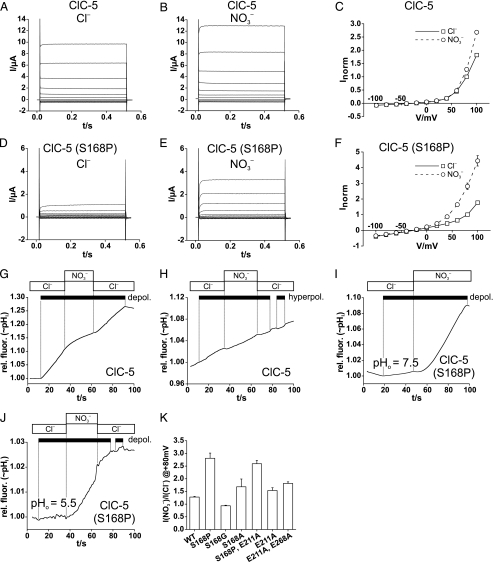FIGURE 5.
Effect of the S168P mutation on ClC-5 conductance and proton
coupling. A and B, shown are the typical two-electrode
voltage-clamp traces of oocyte-expressed ClC-5 in
Cl–-containing (A) or
 -containing (B) solutions.
C, shown are the steady-state I/V curves from such
experiments (averaged from 19 oocytes from seven batches; normalized for each
oocyte to current in Cl– at +80 mV, with mean current of 3.01
± 0.35 μA). D–F, shown are the current properties of
the S168P mutant measured as in A–C. The data in F
show means from 23 oocytes from five batches, normalized to I in
Cl– at +80 mV, with mean I of 0.79 ± 0.17
μA. Voltage-clamp protocols were performed in A–F as
described in the legend to Fig. 1.
G, shown is an example of less efficient depolarization
(depol.)-induced alkalinization by ClC-5 in the presence of
-containing (B) solutions.
C, shown are the steady-state I/V curves from such
experiments (averaged from 19 oocytes from seven batches; normalized for each
oocyte to current in Cl– at +80 mV, with mean current of 3.01
± 0.35 μA). D–F, shown are the current properties of
the S168P mutant measured as in A–C. The data in F
show means from 23 oocytes from five batches, normalized to I in
Cl– at +80 mV, with mean I of 0.79 ± 0.17
μA. Voltage-clamp protocols were performed in A–F as
described in the legend to Fig. 1.
G, shown is an example of less efficient depolarization
(depol.)-induced alkalinization by ClC-5 in the presence of
 compared with Cl–.
Similar results were obtained in 17 experiments. H, hyperpolarization
(hyperpol.) does not elicit intracellular acidification with ClC-5,
in contrast to AtClC-a (Fig.
1I). Similar results were obtained in 13 experiments.
I and J, shown is the drastically increased
compared with Cl–.
Similar results were obtained in 17 experiments. H, hyperpolarization
(hyperpol.) does not elicit intracellular acidification with ClC-5,
in contrast to AtClC-a (Fig.
1I). Similar results were obtained in 13 experiments.
I and J, shown is the drastically increased
 exchange
activity with ClC-5 (S168P), as shown by Fluorocyte with
pHo 7.5 (I) or with pHo 5.5
(transport against gradient) (J), resembling in this respect AtClC-a
(Fig. 1G and
H). Similar results were obtained in 21 (I) and
eight (J) experiments. K, shown is a ratio of currents at
+80 mV measured with extracellular
exchange
activity with ClC-5 (S168P), as shown by Fluorocyte with
pHo 7.5 (I) or with pHo 5.5
(transport against gradient) (J), resembling in this respect AtClC-a
(Fig. 1G and
H). Similar results were obtained in 21 (I) and
eight (J) experiments. K, shown is a ratio of currents at
+80 mV measured with extracellular  and Cl–, respectively, for ClC-5 and several mutants,
determined as in Fig.
4F. The number of oocytes used for averages are as
follows: ClC-5, 19; ClC-5(S168P), 23; ClC-5(S168G), 17; ClC-5(S168A), 2;
ClC-5(S168P,E211A), 6; ClC-5(E211A), 10; ClC-5(E211A,E268A), 34). Error
bars indicate S.E. rel. fluor., relative fluorescence.
and Cl–, respectively, for ClC-5 and several mutants,
determined as in Fig.
4F. The number of oocytes used for averages are as
follows: ClC-5, 19; ClC-5(S168P), 23; ClC-5(S168G), 17; ClC-5(S168A), 2;
ClC-5(S168P,E211A), 6; ClC-5(E211A), 10; ClC-5(E211A,E268A), 34). Error
bars indicate S.E. rel. fluor., relative fluorescence.

